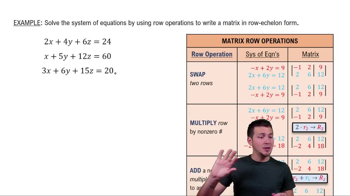Table of contents
- 0. Review of Algebra4h 16m
- 1. Equations & Inequalities3h 18m
- 2. Graphs of Equations43m
- 3. Functions2h 17m
- 4. Polynomial Functions1h 44m
- 5. Rational Functions1h 23m
- 6. Exponential & Logarithmic Functions2h 28m
- 7. Systems of Equations & Matrices4h 6m
- 8. Conic Sections2h 23m
- 9. Sequences, Series, & Induction1h 19m
- 10. Combinatorics & Probability1h 45m
7. Systems of Equations & Matrices
Introduction to Matrices
Problem 23e
Textbook Question
Find the partial fraction decomposition for each rational expression. See Examples 1–4. (-3)/(x^2(x^2 + 5))
 Verified step by step guidance
Verified step by step guidance1
Step 1: Identify the form of the rational expression. In this case, the expression is in the form of a proper rational function because the degree of the numerator is less than the degree of the denominator.
Step 2: Identify the factors of the denominator. The denominator has two factors: x^2 and (x^2 + 5).
Step 3: Write the expression as a sum of partial fractions. Each fraction will have a denominator of one of the factors and a numerator of a constant or a polynomial of degree less than the denominator. In this case, the expression can be written as A/x + B/x^2 + C/(x^2 + 5), where A, B, and C are constants to be determined.
Step 4: Multiply both sides of the equation by the common denominator to clear the fractions. This will result in an equation that can be solved for A, B, and C.
Step 5: Solve the resulting equation for A, B, and C. This can be done by equating coefficients for like terms on both sides of the equation and solving the resulting system of linear equations.
Recommended similar problem, with video answer:
 Verified Solution
Verified SolutionThis video solution was recommended by our tutors as helpful for the problem above
Video duration:
9mPlay a video:
Was this helpful?
Key Concepts
Here are the essential concepts you must grasp in order to answer the question correctly.
Rational Expressions
A rational expression is a fraction where both the numerator and the denominator are polynomials. Understanding rational expressions is crucial for performing operations like addition, subtraction, and decomposition. In this context, the expression (-3)/(x^2(x^2 + 5)) is a rational expression that requires decomposition into simpler fractions.
Recommended video:
Guided course

Rationalizing Denominators
Partial Fraction Decomposition
Partial fraction decomposition is a method used to express a rational function as a sum of simpler fractions. This technique is particularly useful for integrating rational functions or simplifying complex expressions. The goal is to break down the given rational expression into components that are easier to work with, based on the factors of the denominator.
Recommended video:

Decomposition of Functions
Polynomial Factorization
Polynomial factorization involves breaking down a polynomial into its constituent factors, which can be linear or irreducible quadratic expressions. This is essential for partial fraction decomposition, as the form of the factors determines how the decomposition is structured. In the given expression, x^2 and (x^2 + 5) are the factors that will guide the decomposition process.
Recommended video:
Guided course

Introduction to Factoring Polynomials

 4:35m
4:35mWatch next
Master Introduction to Matrices with a bite sized video explanation from Patrick Ford
Start learningRelated Videos
Related Practice











